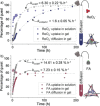Embedding and Positioning of Two FeII4 L4 Cages in Supramolecular Tripeptide Gels for Selective Chemical Segregation
- PMID: 30921499
- PMCID: PMC6563161
- DOI: 10.1002/anie.201900429
Embedding and Positioning of Two FeII4 L4 Cages in Supramolecular Tripeptide Gels for Selective Chemical Segregation
Abstract
An unreported d,l-tripeptide self-assembled into gels that embedded FeII4 L4 metal-organic cages to form materials that were characterized by TEM, EDX, Raman spectroscopy, rheometry, UV/Vis and NMR spectroscopy, and circular dichroism. The cage type and concentration modulated gel viscoelasticity, and thus the diffusion rate of molecular guests through the nanostructured matrix, as gauged by 19 F and 1 H NMR spectroscopy. When two different cages were added to spatially separated gel layers, the gel-cage composite material enabled the spatial segregation of a mixture of guests that diffused into the gel. Each cage selectively encapsulated its preferred guest during diffusion. We thus present a new strategy for using nested supramolecular interactions to enable the separation of small molecules.
Keywords: chemical separation; host-guest systems; low-molecular-weight gelators; metal-organic cages; self-assembly.
© 2019 The Authors. Published by Wiley-VCH Verlag GmbH & Co. KGaA.
Conflict of interest statement
The authors declare no conflict of interest.
Figures




References
-
- None
-
- Jones C. D., Steed J. W., Chem. Soc. Rev. 2016, 45, 6546–6596; - PubMed
-
- Spitzer D., Rodrigues L. L., Straßburger D., Mezger M., Besenius P., Angew. Chem. Int. Ed. 2017, 56, 15461–15465; - PubMed
- Angew. Chem. 2017, 129, 15664–15669;
-
- Hisamatsu Y., Banerjee S., Avinash M. B., Govindaraju T., Schmuck C., Angew. Chem. Int. Ed. 2013, 52, 12550–12554; - PubMed
- Angew. Chem. 2013, 125, 12782–12786;
-
- Borré E., Stumbé J.-F., Bellemin-Laponnaz S., Mauro M., Angew. Chem. Int. Ed. 2016, 55, 1313–1317; - PubMed
- Angew. Chem. 2016, 128, 1335–1339;
Publication types
Grants and funding
LinkOut - more resources
Full Text Sources

